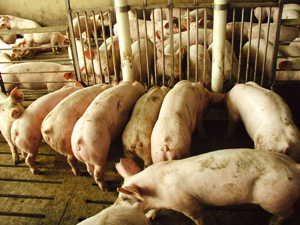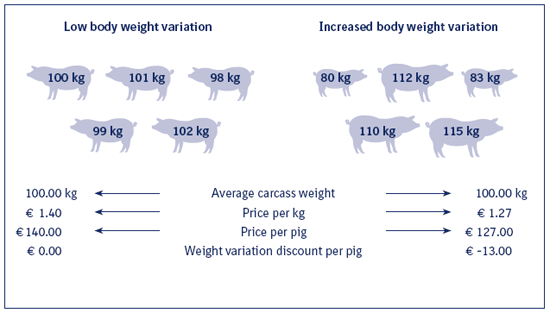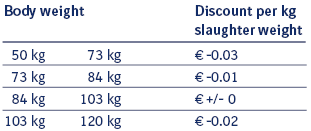2.5 What is the economic value of low body weight variation?
In a group of pigs Ileitis is not affecting each pig at the same time or to the same degree. Some pigs will show a more severe loss in growth and feed conversion than other pigs. This might be due to varying immunity levels and/or due to the fact that the disease is not affecting each animal of a group at the same time. In any case the body weight variation of the affected group can be substantially increased compared to pigs without the disease (picture 2.5 a).

Picture 2.5 a
(by T. Hardge)
Increased body weight variation in fatteners.
This is economically important because the average price per kg slaughter weight is lower in a group of pigs with higher body weight variability compared to a more uniform group of pigs even if the average body weight is identical (Figure 2.5 a).

Figure 2.5 a
The influence of slaughter weight variation
on the slaughter price and weight discounts
per pig. (Euro-Reference grading grid – 2002; €1.4 base price, optimal weight window 84 kg to
103 kg).
Slaughter houses in Europe pay more money for uniform pig batches compared to a group of pigs with higher body weight variation. This is justified by the fact that uniform pigs have lower slaughter processing costs (less labour, more mechanics).
Generally, a “carcass grading grid” is applied for the payment of pigs at the slaughter house, which basically includes region and slaughter house specific settings for the base price, for the discounts per kg slaughter weight above/below the desired weight window and for premiums and discounts per % meat content. Especially light weight pigs below the desired weight window have a substantial influence on the average carcass price of the whole group even if the majority of the pigs meet the desired weight window specifications. The financial loss in €/pig due to not meeting the desired body weight specification is called “weight discounts” or “packer penalty”. A weight discount of €1 for a group of pigs means that on average each pig of the slaughtered batch will loose €1 due to the fact that some pigs of the group can not meet the desired weight window.
Figure 2.5 b shows 2 batches of fatteners with nearly the same average body weight but with different body weight variation (red = increased, blue = low). In the group with high body weight variation, less pigs can meet the desired optimal weight window and the percentage of lightweight pigs is increased. It should be noted that lightweight pigs (below the optimal weight window) lead to higher financial losses than heavyweight pigs (above the optimal weight window).

Figure 2.5 b
Two batches of finishers
with different slaughter weight variation.
Table 2.5 a shows as an example the weight
specifications of a commercial grading grid.

Table 2.5 a
Weight specifications in a commercial grading
grid.
The optimal weight window is between 84kg and 103kg slaughter weight. Considering a base price of €1.40 per kg slaughter weight, a pig with 3kg below the optimal weight limit (70kg) would achieve €1.20 per kg slaughter weight and a pig with 3 kg above the weight window (106kg) would still get €1.34 per kg slaughter weight. The resulting weight discount for the pig below (-3kg) and above (+3kg) the desired weight window would be €14.00/pig and €2.16/pig, respectively. Therefore, the real price penalty comes from the lightweight pig. Besides, losses due to overweight or excessively fat pigs are much easier to control by sequential pre-slaughter-sorting compared to moving lightweight pigs into the desired weight group. Nevertheless, additional costs at the farm due to extra labour for sorting and extra transportation costs are directly related to increased body weight variation and should be considered in farm specific economic calculations.
Growing pigs with better uniformity is a smart way to receive a better price at the slaughter house. This opportunity for increasing the income of the farmer should not be missed by controlling Ileitis.
© Boehringer Ingelheim Animal Health GmbH, 2006
All rights reserved. No part of this Technical Manual 3.0 may be reproduced or transmitted in any form or by any means, electronic or photocopy, without permission in writing from Boehringer Ingelheim Animal Health GmbH.




